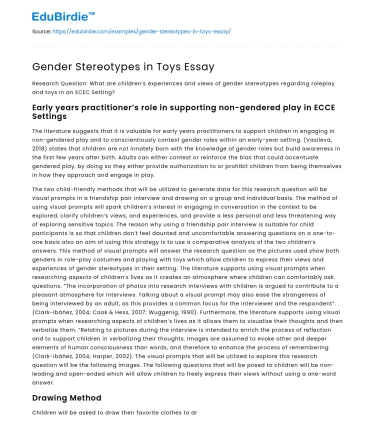Research Question: What are children’s experiences and views of gender stereotypes regarding roleplay and toys in an ECEC Setting?
Early years practitioner’s role in supporting non-gendered play in ECCE Settings
The literature suggests that it is valuable for early years practitioners to support children in engaging in non-gendered play and to conscientiously contest gender roles within an early-year setting. (Vasileva, 2018) states that children are not innately born with the knowledge of gender roles but build awareness in the first few years after birth. Adults can either contest or reinforce the bias that could accentuate gendered play, by doing so they either provide authorization to or prohibit children from being themselves in how they approach and engage in play.
Save your time!
We can take care of your essay
- Proper editing and formatting
- Free revision, title page, and bibliography
- Flexible prices and money-back guarantee
The two child-friendly methods that will be utilized to generate data for this research question will be visual prompts in a friendship pair interview and drawing on a group and individual basis. The method of using visual prompts will spark children’s interest in engaging in conversation in the context to be explored, clarify children’s views, and experiences, and provide a less personal and less threatening way of exploring sensitive topics. The reason why using a friendship pair interview is suitable for child participants is so that children don’t feel daunted and uncomfortable answering questions on a one-to-one basis also an aim of using this strategy is to use a comparative analysis of the two children’s answers. This method of visual prompts will answer the research question as the pictures used show both genders in role-play costumes and playing with toys which allow children to express their views and experiences of gender stereotypes in their setting. The literature supports using visual prompts when researching aspects of children’s lives as it creates an atmosphere where children can comfortably ask questions. “The incorporation of photos into research interviews with children is argued to contribute to a pleasant atmosphere for interviews. Talking about a visual prompt may also ease the strangeness of being interviewed by an adult, as this provides a common focus for the interviewer and the respondent”. (Clark-Ibáñez, 2004; Cook & Hess, 2007; Wuggenig, 1990). Furthermore, the literature supports using visual prompts when researching aspects of children’s lives as it allows them to visualize their thoughts and then verbalize them. “Relating to pictures during the interview is intended to enrich the process of reflection and to support children in verbalizing their thoughts. Images are assumed to evoke other and deeper elements of human consciousness than words, and therefore to enhance the process of remembering (Clark-Ibáñez, 2004; Harper, 2002). The visual prompts that will be utilized to explore this research question will be the following images. The following questions that will be posed to children will be non-leading and open-ended which will allow children to freely express their views without using a one-word answer.
Drawing Method
Children will be asked to draw their favorite clothes to dress up in the role-play area and what are their favorite toys to play with within the setting. This will be carried out in a small group using a large placement and an individual basis using a bubble template, to carry out a comparative analysis to see if children are influenced by others on what to draw regarding stereotyping around role play and toys within the settings. This method is suitable for child participants and answers the research questions as it allows children to creatively express their experiences and views of gender stereotyping in roleplay and toys in their setting in a developmental age-appropriate manner. The literature suggests that using drawing as a method of researching an aspect of children’s lives within a setting allows children to be more involved in the research and express themselves creatively. “The advantage of using drawing with children is that it can be creative, fun, and can encourage children to be more actively involved in the research. The use of drawing gives children time to think about what they wish to portray. The image can be changed and added to, which gives children more control over their form of expression”. (Shaver et al, 1993).
Bibliography
- Cook, T., & Hess, E. (2007). What the camera sees and from whose perspective. Fun methodologies for engaging children in enlightening adults. Childhood, 14(1), 29–45
- Clark-Ibáñez, M. (2004). Framing the social world through photo-elicitation interviews. American Behavioural Scientist, 47(12), 1507–1527.
- Harper, D. (2002). Talking about pictures: A case for photo elicitation. Visual Studies, 17(1), 13–26.
- Shaver, T., V. Francis, and L. Barnett (1993) Drawing as Dialogue: A qualitative approach to needs assessment for health education planning, ERG Technical Notes series No.2, Liverpool School of Tropical Medicine: Liverpool.
- Vasileva, V. (2018) The educator’s role in supporting non-gendered play in early childhood education settings. Volume 5, Issue 2 Available online: https://childrensresearchnetwork.org/knowledge/resources/the-educators-role-in-supporting-non-gendered-play-in-early-childhood-education-settings
- Wuggenig, U. (1990). Die Fotobefragung als projektives Verfahren. [Photo interviews as a projective method]. Angewandte Sozialforschung, 16(1/2), 109–129
Did you like this example?
Make sure you submit a unique essay
Our writers will provide you with an essay sample written from scratch: any topic, any deadline, any instructions.
Cite this paper
-
APA
-
MLA
-
Harvard
-
Vancouver
Gender Stereotypes in Toys Essay.
(2024, February 28). Edubirdie. Retrieved December 31, 2024, from https://edubirdie.com/examples/gender-stereotypes-in-toys-essay/
“Gender Stereotypes in Toys Essay.” Edubirdie, 28 Feb. 2024, edubirdie.com/examples/gender-stereotypes-in-toys-essay/
Gender Stereotypes in Toys Essay. [online].
Available at: <https://edubirdie.com/examples/gender-stereotypes-in-toys-essay/> [Accessed 31 Dec. 2024].
Gender Stereotypes in Toys Essay [Internet]. Edubirdie.
2024 Feb 28 [cited 2024 Dec 31].
Available from: https://edubirdie.com/examples/gender-stereotypes-in-toys-essay/
copy






 Stuck on your essay?
Stuck on your essay?

